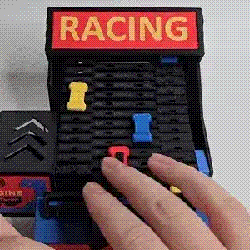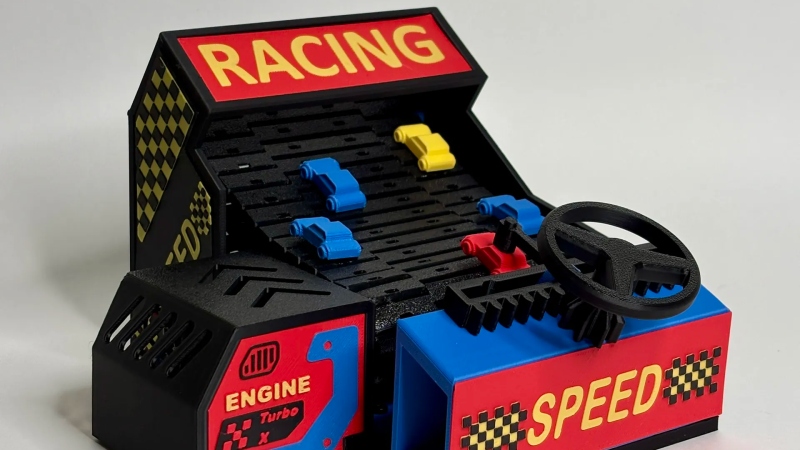Quality 3D printing is a common hobbyist tool nowadays, and [wontonnn]’s mini arcade car racing game really shows off how 3D printing can bring parts from functional to fantastic. There are quite a few details we like in [wontonn]’s design, so let’s take a closer look.
 The mini mechanical game is one of those treadmill-based car racing games in which the player navigates a little car between an onslaught of belt-borne obstacles. A little DC motor spins things up in a modular side assembly, and a hand-cranked option is available. The player’s car attaches via a magnet to a steering arm; if the player’s car gets knocked off the magnet, game over.
The mini mechanical game is one of those treadmill-based car racing games in which the player navigates a little car between an onslaught of belt-borne obstacles. A little DC motor spins things up in a modular side assembly, and a hand-cranked option is available. The player’s car attaches via a magnet to a steering arm; if the player’s car gets knocked off the magnet, game over.
Treadmill belt segments print as large pre-assembled pieces, with ends that snap together without connectors. Belts like this are sometimes tricky, so this is worth keeping in mind should one ever need a similar part. Since there are no external fasteners or hardware to depend on, one could resize it easily to suit their own project purposes.
The finishing touches on the whole assembly look great. It used to be that the sort of colors and lettering seen here would come from a sticker or label, but [wontonn] gets clean lines and colors by raising (or sinking) different parts of the design. The checkerboard pattern, for example, has the light squares raised for printing in a different color.
Electromechanical arcade games have an appeal all their own, being a fusion of both mechanical and electric design that comes together in a special way. Want to make your own? Get inspired by the classic Lunar Lander reimagined, or check out this LEGO treadmill racer that takes an entirely different approach to the concept.















That’s a lovely looking piece of kit!
What’s old is new again. This is the toy I had in early 90s https://i.ibb.co/Tqvn7XyM/1.jpg
Immediately thought of that toy when I saw this, I had a very similar one. Ah, nostalgia trip…
I just spent six hours on the busiest highway in North America, observing some of the most aggressive drivers. That red car is certainly either a BMW or an Audi. And its indicator lights don’t work.
Narrator: In fact, the indicator lights would work, had they only been turned on.
The orange lights at the corners of a BMW or Audi aren’t used in pairs for turning.
They’re all used together for magically granting permission to park wherever the driver wants.
If only they were still orange/amber/yellow, like sane countries.
No, nowadays Fine German Automobiles ship to North America with red turn signals. Srsly.
Talk about a legacy: A penny-pinching move by Ford to combine brake lights and turn signals leads to ongoing compromised safety, a century on.
Electromechanical arcade games and no mention of Tim Hunkin? His YouTube series ‘the secret life of components’ is excellent. I hope to visit his London arcade at some point.
Was just there recently, he uses a similar concept for this game:
https://youtu.be/sX3RdD2qwdg
Please, if designing toys or household items that incorporate magnets, design them to be fully captive. Solid print layer, print hole, pause printer, insert magnet, resume print. Epoxies, glues and interference/tight fits are not permanent. Kids swallow magnets and need life-saving surgery because the magnets perforate their gut.
it´s simple: just not eat them TOO fast. Give some time between two magnets for intestinal transit !
Looks like fun!
Some thoughts:
– A barrel cam with suitable gear ratio could be used for demo mode.
– An odometer could serve as the score.
– Split the road into separate lanes, each geared slightly differently, to make the traffic more random.